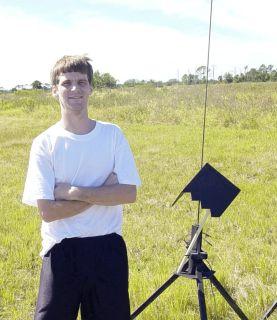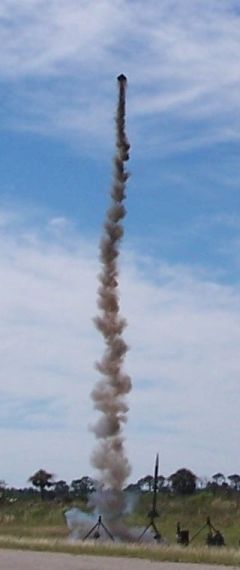Art Applewhite Rockets Stealth 38mm
Art Applewhite Rockets - Stealth (38mm) {Kit}
Contributed by Donald Besaw Jr
| Construction Rating: | starstarstarstarstar |
| Flight Rating: | starstarstarstarstar |
| Overall Rating: | starstarstarstarstar |
| Manufacturer: | Art Applewhite Rockets  |

Brief:
This is a L1 capable 38mm MPR and HPR version of Art Applewhite's Stealth Qubit. This is also a prototype version, not a production kit.
Construction:
The kit came with:
- 3 foamboard side panels
- 1 bottom bulkhead
- 1 38mm 4" motor mount tube
- 1 marking guide
The instructions consist of three pages with text and black and white photos, all of which are typical Art Applewhite material and very easy to understand. To build this kit, you need:
- X-Acto knife with #11 blade
- Metal ruler
- Elmer's white glue
- 220 grit sandpaper
I started by cutting out the marking guide from the cardstock. Since one panel had the stealth pattern precut and launch rod hole premarked, all I had to do was cut out the launch rod hole. I then marked and cut out the stealth pattern on the remaining two panels followed by cutting the required 45 degree angles on all three panels. White glue was used to glue the three panels together. After letting it dry for a while, I applied several fillets for strength. I then cut out the hole for the motor mount tube and launch rod hole in the premarked bottom bulkhead and glued it into place. Several more fillets were added on the bulkhead for strength. I decided that I would use epoxy for installing and filleting the motor mount tube since these motors generate quite a bit of heat as white glue tends to soften when heated. Maybe this was overkill. Lastly, I applied white glue to all exposed foam edges to protect it from the elements.
PROS: Very easy and quick construction.
CONS: None
Finishing:
Since this model is already on black foamboard it does not require painting, but I suppose you could paint it if you wanted to. You might want to apply white glue to all exposed foam edges first as the paint solvents could dissolve the foam. You could also use clear spray enamel but I decided to pass as I wanted to keep the flat black of the foamboard.
PROs: No real finishing required.
CONs: None.
Construction Rating: 5 out of 5

Flight:
The recommended motors for this kit are the Ellis Mountain SU H48, CTI Pro38 1 grain G69 and G79SS motors, Aerotech H45 SU, and Aerotech RMS 38/240 reloads (except the H242T) without ejection charge powder. I am sure the new Aerotech RMS 38/120 and G61W reload would be a great match for this kit as well and I will eventually try it.
The only prepping this kit requires is friction fitting the motor into place, that's it. It couldn't be any easier.
For my first test flight, I loaded an Aerotech RMS 38/240 H73J reload, plugged the forward closure ejection well with dog barf, wrapped about two layers of masking tape on the casing, friction fit it into place, and then applied another layer of tape to the motor mount tube/casing joint. I then loaded the rocket on the pad using a 1/4 inch launch rod and a piece of PVC pipe as a standoff.
At launch, the H73J took a few seconds to pressurize and then lifted the Stealth relatively fast but straight for a long burn, low thrust motor. A fairly rapid spinning motion was noticed during boost.
Recovery:
This rocket uses aerobrake recovery. After motor burnout, the rocket flipped over and gracefully fell to earth with a slow spinning motion and also left a neat smoke trail from the delay element. Luckily, the delay element burned out before impact and the rocket hit the ground fairly softly with no damage.
To reduce the risk of grass fires, I would use either a short or medium delay with the reloads so the delay element can burn itself out before landing.
PROs: Flies great and stays in sight throughout the entire flight. Recovers quickly and easily.
CONs: None.
Flight Rating: 5 out of 5
Summary:
I really liked building and flying this kit. This was the easiest HPR kit that I have built and flown. The aerobrake recovery is sufficient to bring it in safely and since it really doesn't go that high, you really won't need to worry about losing expensive RMS casings.
Again, this is a prototype kit so there might be some changes made to the production kits but I would count on the same ease of assembly and flight performance from the production kits. For $25.00, it's a good value.
Main PROs: Great instructions, ease of assembly, great flight performance and recovery.
Main CONs: None.
Overall Rating: 5 out of 5
 |
 |
Flights
Sponsored Ads
 |
 |




![Calling Marshall Applewhite [Explicit] Calling Marshall Applewhite [Explicit]](https://m.media-amazon.com/images/I/51MeUaBWTkL._SL500_.jpg)





